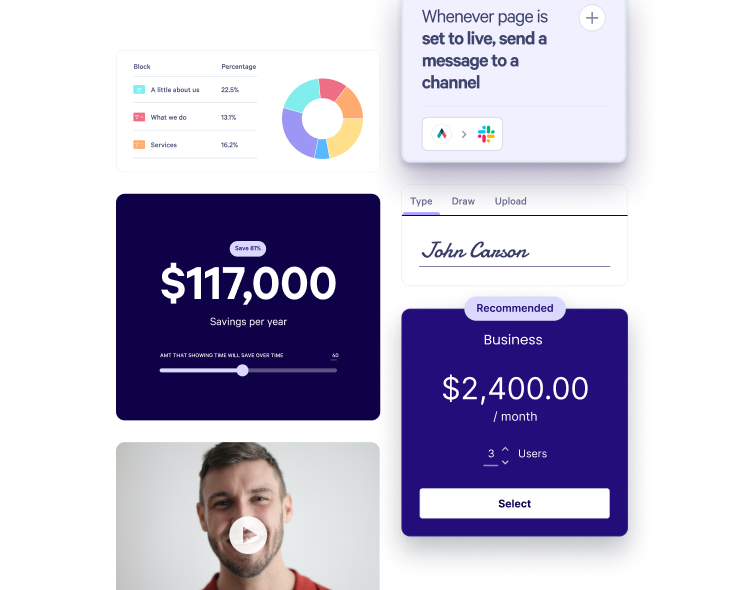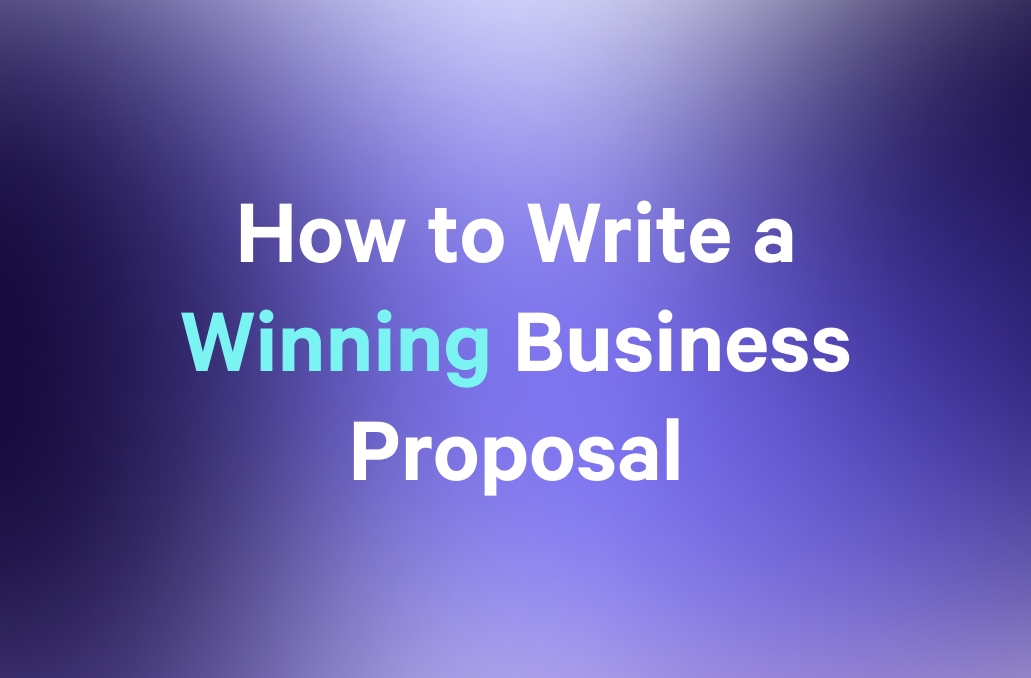Have you ever felt the sting of presenting a proposal only to watch it fall flat? Despite pouring your heart and soul into it, all you get back are crickets and cleared throats. The reality is that crafting a proposal that captivates and convinces isn't a matter of effort alone—it's about strategy. And that strategy starts with a well-structured outline.
In this article, we'll unlock the secrets of an effective proposal outline and explore the elements that make a proposal not just good but remarkable. This first step will help you align your ideas with your client's needs.
Key takeaways
- A good proposal outline can help you organize your ideas and the key points you need to make to persuade your prospect.
- Each part of the proposal outline should serve a specific purpose
- You might want to share your proposal outline with a peer or even your prospect to ensure it covers all of the critical information your proposal will need
What is a proposal outline?
A proposal outline is a framework that organizes your ideas and pitches into a coherent proposal structure, ensuring every crucial element of is considered and clearly presented. It’s the backbone of your proposal, guiding you from the introduction to the conclusion, ensuring a logical flow and that no key points are missed.
A well-crafted proposal outline consists of several parts, each serving a specific purpose:
- Introduction: Sets the stage, introduces the problem or need, and captures interest.
- Problem Statement: Clearly defines the issue that your proposal aims to solve.
- Solution Overview: Outlines your proposed solution and its benefits.
- Deliverables and Timelines: Specifies what will be delivered and when.
- Cost Estimate: Provides a clear and detailed breakdown of costs associated with the proposal.
- Conclusion: Summarizes the proposal, reinforcing the value and feasibility of your solution.
By using a proposal outline, you ensure your proposal is not only complete but also tailored to address the needs and concerns of your clients. There is also a good selection of proposal management software (and even proposal templates) to help you futher speed up and scale the process here. In fact, we might know of a few ourselves…
Importance of outlining
Why spend extra time on a proposal outline? Well, outlining isn't just about organizing your thoughts—it's about setting a strategic foundation for your proposal and ultimately creating the proposal structure that will guide your process. Here’s why it’s absolutely crucial:
- Enhances clarity and focus: An outline keeps your proposal focused on the client’s needs and your solution. It prevents you from veering off-topic and ensures every part of the proposal pushes toward the end goal—securing approval.
- Saves time in the long run: It might seem like extra work at the start, but having a clear outline actually speeds up the writing process. You know exactly what to write about in each section, cutting down on revisions and rewrites.
- Improves persuasiveness: A structured proposal is a persuasive proposal. With all points logically flowing from one to the next, your argument builds momentum- and with it, a compelling case to your client.
- Facilitates collaboration: When working in a team, an outline acts as a shared plan. Everyone knows their part, reducing overlap and ensuring all necessary points are covered.
- Makes a professional impression: A well-organized proposal reflects professionalism and attention to detail. It shows potential clients that you are thorough and capable, boosting their confidence in your abilities.
In short, an outline isn’t just a planning tool—it’s a critical element that elevates the quality and effectiveness of your proposal. By taking the time to outline, you're paving the way for a smoother, more impactful presentation that aligns perfectly with your client's expectations.
Key elements of a detailed project proposal outline
Crafting a project proposal is like telling a story where you're the hero who can solve the client's problem. To tell this story effectively, you need several key elements, communicating your understanding, plan, and commitment to the project's success. These elements are:
- Introduction
Kick off your proposal by grabbing attention. Introduce the problem and hint at the solution, making sure to connect emotionally (and logically) with your potential client.
- Problem statement
Dive deep into the problem. Demonstrate your understanding of the client's needs and challenges. Show empathy and expertise, making it clear why this issue needs resolution.
- Solution overview
This is where you shine. Outline your proposed solution and the unique benefits it offers. Be clear and concise, using simple terms that convey value and feasibility.
- Objectives and goals
Define what success looks like. Detail the objectives your solution aims to achieve, aligning them closely with the client’s requirements.
- Methodology and approach
Explain how you plan to achieve the outlined objectives. This section should reassure the client of your method's effectiveness and your team's capability.
- Deliverables
Specify what you will deliver, including tangible products, reports, and results. This sets clear expectations and helps avoid scope creep.
- Timeline
Map out the project timeline. Include key milestones and deadlines to demonstrate your project management skills and realistic approach.
- Cost estimate
Provide a detailed breakdown of the project cost. Transparency here builds trust and helps the client understand the value they are getting.
- Conclusion
Wrap up with a strong conclusion that reiterates the benefits of your proposal. Encourage the client to take action, and make it easy for them to say Yes.
By including these elements, your proposal will not only be comprehensive but also tailored to clearly communicate how you are the best choice for the project.

How to create the perfect proposal structure (then fill it in)
Creating the perfect proposal outline is like preparing a recipe that’s tailored to taste—it needs the right ingredients, a pinch of creativity, and a good understanding of who's going to enjoy it! Here’s a simple, effective way to put it all together:
Step 1: Understand the client’s needs
Begin by thoroughly researching your client’s industry, challenges, and specific needs. The more you know, the better you can tailor your proposal to speak directly to them. Dive into their company reports, read relevant industry news, and analyze their competitors. This groundwork enables you to address their unique pain points with precision.
“It’s crucial to always understand business objectives. Everything should tie back to business impact. Expectations should be managed early on, and we should always aim to get an agreeement with customer before we start working together.”
Stan Stojanovic, Customer Success / Growth Partner
Step 2: Define the project scope
Clearly define what the proposal will cover and- importantly- what it won’t. Setting these boundaries early prevents misunderstandings and keeps your proposal laser-focused.
Step 3: Gather your data
Collect all the necessary information, data, and resources that will support your solution. This could include case studies, testimonials, or relevant statistics that reinforce your points. Solid data not only backs up your claims but also builds credibility, showing that your solution is grounded in proven results and sound research.
Step 4: Draft the structure
Using the key elements outlined above, start drafting your proposal. Arrange the sections in a logical order that tells a compelling story, from problem to solution. Each section should naturally lead into the next, creating a seamless narrative that keeps the reader engaged and makes your argument compelling.
Step 5: Write the details
Fill in each section with detailed information. Ensure your writing is clear, persuasive, and directly addresses how you will solve the client’s problem. Use active language, avoid jargon, and be specific about the benefits of your solution. Remember, the goal here is to make it easy for the client to understand and see the value in your proposal.
Step 6: Review and refine
Step back and review your proposal as a whole. Does it flow logically? Is it persuasive? Ask a colleague to proofread it for clarity and coherence. A fresh set of eyes can catch errors you might have missed and provide valuable feedback to improve the overall quality of the proposal.
Step 7: Customize your presentation
Tailor the final document to the client’s preferences. Consider their company culture and the decision-maker’s personal style when finalizing the format and tone. Customization shows you’ve taken the time to understand their business and care about their unique context, making your proposal stand out from more generic submissions.
Include interactive elements that engage your buyers and communicate concepts and value more clearly.

With Qwilr you can easily add interactive elements such as ROI calculators, dynamic pricing tables and flexible dashboards
Step 8: Include a Call To Action
End with a clear, compelling call to action. What do you want the client to do next? Make it easy for them to take the next step, whether it’s scheduling a meeting, signing a contract, or simply getting in touch. A strong CTA helps to turn interest into action, guiding the client towards a positive decision.
With Qwilr, you can make it simple for your prospect to take action. Include an accept field to collect legally binding e-signatures, attach plain-text agreements for consideration or embed a calendar and meeting link.

By following these steps, you’ll create a proposal outline that not only meets the client’s needs but also highlights your capabilities and understanding of their challenges.
6 Top tips for outlining proposals
Here are some top tips to ensure your proposal outlines set you up for success:

Tip 1: Start with a strong hook
Capture your reader's attention from the outset. Use a compelling fact, question, or statement that speaks directly to the reader's interests or pain points.
Tip 2: Keep the client central
Always tailor your proposal outline with the client in mind. Every section should reflect an understanding of their needs, goals, and preferences.
“I always start by getting to know the client’s business and industry inside-out. This helps me figure out their specific challenges and goals, whether it’s driving more leads for a B2B company or boosting sales for an e-commerce store. Then, I put together a plan that directly addresses those needs. It’s not about offering a cookie-cutter solution—it’s about being super relevant to them”
Gianpiero, Digital Marketing Manager, Cloud Assess
Tip 3: Use clear, concise language
Avoid jargon and complex language. Your proposal should be easy to understand, making the client feel confident about what you’re offering. Simple language helps to ensure your message is clear.
“I always make sure to use client-friendly language, limiting the use of technical jargon and explaining any necessary technical terms in layman's terms.”
Seth Bredenkamp, Web Sales Engineer
Tip 4: Visualize the flow
Before writing detailed content, visualize how each section flows into the next. A logical, intuitive flow keeps the reader engaged and makes your arguments more persuasive.
Tip 5: Highlight key benefits
While detailing the features of your solution is important, focusing on the benefits for the client can be even more persuasive. Make it clear how your proposal will solve their problems or improve their situation.
Tip 6: Be realistic and honest
Set realistic expectations about what you can deliver and when. Honesty builds trust and reduces the chance of client dissatisfaction down the line.
By implementing these tips, your outlines will lay the foundations for a proposal that is hard to resist.
Create proposals that impress
We've delved into the nitty-gritty of creating a persuasive proposal outline, focusing on clarity, structure, and a client-centered approach. Your proposal's true power lies in how effectively it addresses your client's needs and highlights your unique solution.
But why stop there? With Qwilr's innovative tools and templates, you can transform your outlines into visually stunning, interactive documents that captivate and convince. If you’re ready to gain a competitive edge and make your proposals irresistible, check out what Qwilr can do for you.
About the author

Marissa Taffer|Founder & President of M. Taffer Consulting
Marissa Taffer is the Founder & President of M. Taffer Consulting. She brings over 15 years of sales and marketing experience across various industries to a broad range of clients.
Frequently asked questions
The length of your proposal should be determined by the complexity of the project and the client’s requirements. Generally, aim for clarity and concision.
Provide a detailed breakdown of costs, including all relevant expenses. Transparency here is crucial—clients appreciate knowing exactly what they are paying for and why.
While you can reuse generic sections like your company overview, always tailor the proposal to each client’s specific needs and circumstances to show that you’ve crafted a solution just for them. Proposal automation software can help speed up the more generic aspects.
Be open to feedback and willing to make adjustments. This flexibility can often strengthen the client relationship and lead to a more successful partnership.
Follow up within a week of submission to show your enthusiasm and commitment. If you haven’t received a response, a gentle reminder every few weeks can keep your proposal top of mind.


